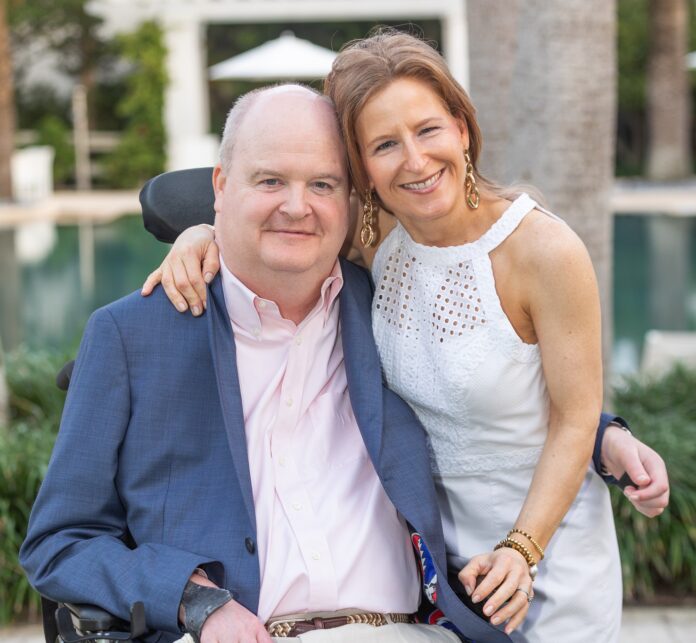
Nearly four decades after Henry Stifel’s spinal cord injury – and after following spinal cord injury research as a philanthropist for more than three – the opportunity came for him to participate in epidural stimulation research at the University of Louisville.
On one level, it was a dream come true, but he had to think carefully about it before accepting.
Before he enrolled, he took stock of his goals. Did he have expectations about what he might gain? Was he doing it only for himself? Finally, he was about to get married and it would require relocating to Louisville from his home in New York City for an extended period of time.
Ultimately, he decided his participation could benefit other older SCI patients and those longer post-injury – he was 55 years old and 39 years post injury. The possibility that he could benefit personally was a bonus – but an exciting one.
“My wife said I would be regretting it for the rest of my life if I didn’t do it,” Stifel said. “I admit I was like a kid in a candy shop – I wanted that candy! But I knew I would have to work extra hard.”
From philanthropist to participant
Stifel was 17 years old in 1982 when an auto accident left him paralyzed, unable to walk or use his hands. With support from his family and community, he got on with life, graduating from high school, then college with a degree in finance and pursuing a career on Wall Street.
Hoping to change the trajectory of spinal cord injury research, dubbed the “graveyard of neuroscience,” Stifel and his father started a foundation to raise money and fund research that would give hope for recovery to people with spinal cord injuries. That foundation eventually merged with the American Paralysis Association and later with what now is known as the Christopher and Dana Reeve Foundation, supporting research and advocacy for individuals with spinal cord injury (SCI).
As a board member of the foundation throughout its history, Stifel followed the work of SCI researchers, particularly UofL professor Susan Harkema and Kentucky Spinal Cord Injury Research Center. He was impressed with the progress they made using implanted epidural stimulators, from Rob Summers, the first individual implanted with a stimulator for SCI research, to additional participants who experienced voluntary movement, improved cardiovascular function, the ability to stand and improved bowel, bladder and sexual function. Some even took steps because of the implant and specialized therapy developed by the UofL team.
Stifel, now in his 50s, was gratified to see this progress and support the work through the foundation, including “The Big Idea,” a 36-participant study of the benefits of epidural stimulation funded by the Reeve Foundation and led by Harkema. The previous participants were younger and had a shorter length of time since their injury. Although he had been to Louisville to participate in other studies, Stifel believed that because it had been nearly 40 years since his injury, it was unlikely he would be able to participate in the epidural stimulation studies.
Then in 2018, Stifel got a call to participate in The Big Idea. Since his deficits were stable, which gave the researchers a solid starting point to document any gains or changes he might experience, he qualified.
When he arrived in Louisville for the study in 2020, he knew that nothing was guaranteed.
“I understood that you need to go in with zero expectations,” Stifel said. “You can only have expectations if the therapy is proven, but it is still being tested. My goal was to be involved and represent others who are injured as long as me. I wanted to help the research progress.”
Blood pressure regulation and stand training
Stifel’s overall health had remained relatively stable in the years since his injury, without many of the comorbidities people with severe SCI often experience. The one side effect he did have was chronic low blood pressure.
“My blood pressure was typically 80/50, which can be debilitating,” he said. “I became used to it, but it is not a healthy way to live. When I was giving a presentation or having a conversation, I would find myself distracted.”
Once enrolled in the study, Stifel underwent preliminary assessments followed by the surgery to implant the electrode on his spine and the epidural stimulator in his abdomen. Then the researchers did a series of mapping sessions in which the stimulator was tested for each of the areas being studied: voluntary leg movement, trunk control and cardiovascular function.
Stifel was randomized into a cardiovascular arm of the study, which required that he monitor his blood pressure every 15 minutes for six hours a day, keeping his systolic blood pressure between 110 and 120. If it dropped below that, he was to adjust the stimulator to regain that level.
Those sessions brought significant improvement for Stifel.
“I didn’t realize how poorly I felt until it was fixed. I guess you have to feel bad to realize what good feels like,” he said. “When my blood pressure maintains a healthy level, it is like a breath of fresh air. My ability to engage, be proactive and live life is so much easier.”
Now, even when he turns off the stimulator, his blood pressure remains above its previous levels for several hours.
Stifel’s study protocol also included 160 two-hour stand training sessions in the lab at UofL Health – Frazier Rehab Institute. Every weekday, he would stand upright in a standing frame with trainers supporting his back, chest and each knee. These sessions were to help Stifel gain strength and independence.
“At the end of the sessions, I could consistently stand for 10-to-16 minutes without knee support,” Stifel said. “The epidural stimulator is more intense and effective than anything else I have experienced.”
Moving the needle
Stifel’s time since injury is the longest of any of the participants in the UofL studies so far.
“I am more of an outlier on the low end, but at 56 years old and nearly 40 years post injury, I think I did great,” he said.
Even Harkema was somewhat surprised that Stifel regained voluntary movement as soon as his early sessions led by Claudia Angeli, assistant professor of bioengineering and director of the epidural stimulation program at KSCIRC.
“I admit we had low expectations of Henry being able to move voluntarily after almost four decades of no movement,” said Harkema, professor of neurological surgery and associate director for KSCIRC. “Even though it supported our theory of the sophistication of the human spinal circuitry, I was stunned when Dr. Angeli was able to find stimulation configurations for him to sit independently and move his toes, ankles, knees and hips in the first sessions. Importantly, this shows that under the right conditions, recovery can happen even decades after injury.”
Now that he has completed his initial part of the study, Stifel is taking part in another study arm in which he will complete another 80 sessions focusing on trunk control and voluntary leg movement.
Once he completes the additional studies, Stifel plans to incorporate training with the stimulator in his daily exercise routine. Although he is not steady enough to stand on his own at home, he will continue that training along with blood pressure regulating, core exercising and any other positive outcomes that might come from this new phase of the study.
“I don’t want to do this study and then shelve it. We accomplished a lot and I want to be able to do more.” Stifel said. “I feel like I won the senior golf tournament, but I still want to beat the kids that have won the Masters. It’s human nature to want more.”
He also is happy to have contributed personally to the overall body of research.
“I think I have helped them move the research needle,” Stifel said. “There have been so many exciting discoveries. Spinal cord injury research has moved from the graveyard of neurological research to interventions that are impacting lives today. This field of research is quickly moving from the traditional fundraising path to one of venture philanthropy and gaining the interest of true capital. Lives are being changed thanks to epidural stimulation, transcutaneous stimulation and the other work being done here and elsewhere.
“This is an amazing research study within the walls of an amazing university. I hope the Louisville community is aware of it and proud of the accomplishments coming from it. It is an amazing time for this field of research.”
Visit Henry Stifel’s blog about his journey with epidural stimulation research at http://henrysjourney.com.
To support spinal cord injury research at the University of Louisville, visit VictoryOverParalysis.org.


































